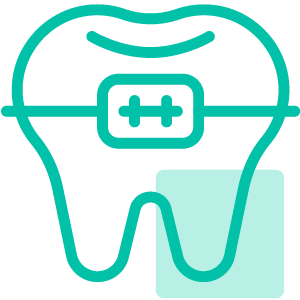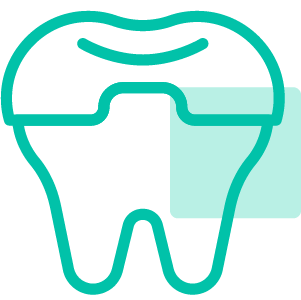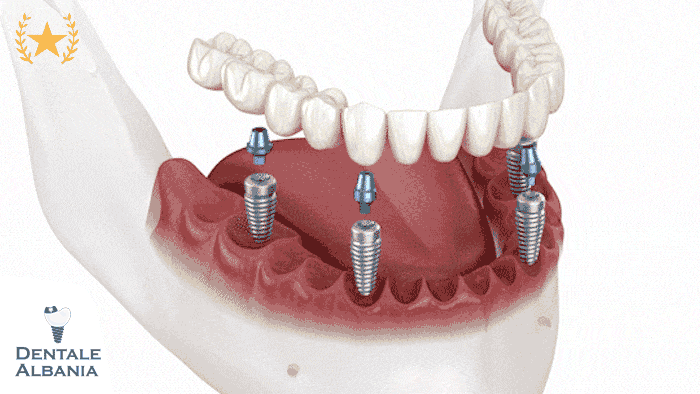Table of Contents
ToggleWhat Is Immediate Placement of Dental Implants and When Is It Used?

Immediate implant placement refers to the process of placing a dental implant directly into the extraction socket immediately after a tooth has been removed. Unlike the traditional method, which requires a healing period of several months before placing the implant, immediate placement capitalizes on the existing socket structure and bone, aiming to reduce overall treatment time and preserve the natural gum and bone architecture.
- Immediate Implant Placement vs Traditional Methods
Traditional implant protocols involve extracting the tooth, allowing the socket to heal (usually 3–6 months), and then placing the implant into the healed bone. Immediate implant placement skips this delay, placing the implant on the same day as the extraction. This eliminates the need for a second surgical intervention and maintains better control over the aesthetic outcome, especially in the anterior maxilla. - Rationale and Timing of Immediate Implants
The primary rationale behind this approach is to minimize bone resorption and preserve soft tissue contours, both of which are prone to change during the post-extraction healing period. Immediate implants must be placed with excellent primary stability (typically with insertion torque above 35–45 Ncm), and the implant site must be infection-free. Timing is critical—atraumatic extraction, proper debridement of the socket, and precise implant positioning are key to success. - When Is Immediate Placement Preferred?
Immediate placement is particularly beneficial in the following clinical situations:- A single anterior tooth with a healthy periodontium and no active infection.
- Patients with high esthetic expectations who prefer to avoid removable temporaries.
- Cases where socket preservation is crucial to maintaining facial contour and avoiding the need for grafting.
- Situations with adequate bone volume and quality to provide sufficient initial stability.
By leveraging the structural support of the fresh socket and minimizing soft and hard tissue changes, immediate implant placement is an increasingly popular solution for achieving rapid functional and esthetic dental restorations.
What Is the Difference Between Immediate and Delayed Dental Implant Loading?
Dental implant loading refers to the timing of placing a prosthetic restoration—like a crown, bridge, or denture—on top of an implant after it’s been surgically inserted into the jawbone. The main difference between immediate and delayed loading lies in when this prosthesis is attached relative to the time of implant placement. Understanding this difference is crucial for determining the right treatment strategy for each patient.
What Is the Difference Between Immediate Loading and Delayed Loading?
- Immediate Loading means the implant is loaded with a functional or non-functional prosthesis within 48 hours of placement. The implant remains exposed to occlusal forces (i.e., biting and chewing) early in the healing process. This requires high initial primary stability, often verified by an insertion torque of ≥ 35–45 Ncm.
- Delayed Loading, on the other hand, follows a traditional protocol where the implant is left undisturbed for 3 to 6 months to allow for osseointegration (the biological fusion of bone to implant). Only after this healing period is the prosthesis placed and the implant loaded functionally.
- Immediate loading is beneficial in reducing treatment time, but success depends heavily on mechanical and biological conditions. Delayed loading, although slower, has a long history of high success rates due to minimal risk of micromovement during healing.
What Is the Difference Between Immediate and Delayed Implants?
- Immediate implant placement refers to inserting the implant at the time of extraction, while delayed implant placement occurs weeks or months later, after soft and hard tissues have healed.
- Biologically, immediate implants must contend with the healing dynamics of the extraction socket, while delayed implants benefit from placing the fixture in healed and remodeled bone, often providing better visibility and surgical access.
- Immediate placement can preserve bone and soft tissue architecture more effectively, especially in esthetic zones. However, it demands meticulous surgical technique and case selection.
What Is the Difference Between Gradual Loading and Sudden Loading?
- Gradual loading (also called progressive loading) introduces occlusal forces in phases—initially non-functional or minimal loads, followed by full load once healing and integration are adequate.
- Sudden loading, typical of many immediate load protocols, applies full functional load at once—usually within the first 48 hours. While it provides quicker function, it also increases the risk of micromovement if the implant isn’t fully stable.
- Gradual loading is ideal in marginal cases, such as when primary stability is borderline or soft bone is present. It allows the bone-implant interface to mature before full masticatory function is applied.
How Successful Are Immediate Dental Implants?
The success of immediate dental implants has been a subject of growing clinical interest due to their ability to shorten treatment time and improve patient satisfaction. While traditionally, dental implants were loaded only after a healing period, advancements in implant design, surface technology, and surgical techniques have made immediate loading a viable and often successful option.
What Is the Success Rate of Immediate Implants?
- Clinical studies and systematic reviews have reported success rates for immediate implants ranging from 90% to 98%, depending on the site, patient selection, and surgical technique.
- A meta-analysis comparing immediate vs delayed placement shows minimal difference in long-term outcomes when strict criteria (like insertion torque and bone quality) are met.
- Factors influencing success include:
- Primary implant stability (insertion torque ≥ 35–45 Ncm)
- Absence of peri-implant infection
- Controlled occlusion with or without functional loading
- Patient’s systemic health and oral hygiene
- Success is higher when immediate placement is combined with delayed or non-functional loading, particularly in challenging anatomical areas.
How Successful Is Immediate Implant Loading?
- Immediate loading with a provisional prosthesis has been widely successful, particularly in full-arch rehabilitations where multiple implants offer cross-arch stabilization.
- Single-tooth replacements in the esthetic zone also show high success rates, although they require very careful case selection and precise execution.
- Longitudinal studies report:
- 1-year survival rates above 95%
- Minimal peri-implant bone loss (<0.25 mm on average)
- High patient-reported outcomes for aesthetics and function
- Common clinical applications with excellent outcomes:
- Edentulous mandibles with fixed full-arch bridges
- Anterior maxilla with soft tissue preservation
- Short-span bridges replacing two to three adjacent teeth
- Failures, when they do occur, are usually linked to micromovement, poor primary stability, or premature loading before osseointegration.
What Are the Advantages of Immediate Placement and Loading?

Immediate placement and loading of dental implants offer several clinical and practical benefits for both patients and clinicians. When executed correctly, this approach can drastically reduce treatment time while maintaining high functional and aesthetic outcomes. Here are the main advantages of this modern technique:
What Are the Advantages of Immediate Implant Placement?
- Preservation of gingival contour: Placing the implant immediately after extraction helps maintain the natural shape of the gum tissue, especially in the anterior zone. This is crucial for achieving ideal esthetics.
- Less bone resorption post-extraction: Immediate implant placement limits alveolar bone shrinkage, which typically begins within days after tooth extraction. This helps maintain volume and supports better long-term stability.
- Fewer surgical interventions: A single surgical procedure eliminates the need for staged surgeries, which is not only less invasive but also more convenient for the patient.
- Psychological benefit: Patients often feel reassured knowing the implant has been placed right away and their missing tooth has been “immediately addressed.”
What Are the Advantages of Immediate Loading of Dental Implants?
- Reduced treatment time: Immediate loading eliminates the waiting period typically associated with delayed implant protocols, allowing patients to regain function and aesthetics within 48 hours.
- Avoidance of removable temporaries: Instead of wearing uncomfortable dentures during healing, patients receive a fixed provisional restoration right after surgery.
- Improved patient satisfaction: With fewer visits, faster results, and aesthetic restorations, patient acceptance is higher compared to traditional methods.
- Better tissue shaping: Provisional restorations can help sculpt the soft tissue architecture, contributing to a more natural-looking final prosthesis.
Are Immediate Implants Better?
- In many cases, yes—immediate implants can outperform delayed ones, especially in terms of treatment efficiency and esthetic outcome.
- However, this advantage is case-dependent:
- They’re ideal when there’s sufficient bone volume, good soft tissue quality, and no active infection.
- Not all cases qualify; delayed placement remains safer in compromised sites.
- They are especially beneficial for:
- Patients with tight schedules
- Esthetically critical zones (like front teeth)
- Those seeking immediate function and confidence
What Are the Disadvantages and Complications of Immediate Implants?
While immediate implant placement and loading offer impressive benefits, they are not without risks. These procedures require precise execution, and success largely depends on several clinical and patient-related factors. Below are the main disadvantages and complications associated with immediate implants.
What Are the Disadvantages of Immediate Loading Implants?
- Risk of micromovement: One of the greatest risks is micromovement of the implant during the early healing phase. This can prevent proper osseointegration, leading to implant failure.
- Compromised aesthetics in poor cases: In patients with thin biotypes or insufficient soft tissue, immediate loading may compromise the esthetic result, especially in the anterior region.
- Not suitable for all cases: Immediate loading requires high initial stability (usually >35–45 Ncm of torque), which is not always achievable, especially in low-density bone.
- Surgical precision required: The margin for error is smaller compared to delayed loading. Misplaced implants or poor angulation can be harder to correct after immediate loading.
What Are the Complications of Immediate Implants?
- Failure to achieve primary stability: Without sufficient torque during insertion, immediate loading is contraindicated. This can result in the implant being mobile or failing entirely.
- Increased risk of peri-implantitis: Early exposure of implants to functional forces, especially in patients with poor oral hygiene, can trigger inflammation or infection.
- Bone loss and soft tissue recession: If the implant is placed too shallow or deep, or the extraction site is compromised, marginal bone resorption and soft tissue loss may occur.
- Fracture of provisional restorations: Particularly in full-arch or partial bridges, immediate prostheses may fracture under excessive occlusal load if not properly designed or adjusted.
- Higher cost and technical demand: Immediate implants may require additional planning tools (like CBCT, guided surgery), more frequent follow-ups, and a higher skill set—contributing to higher costs.
Immediate implants can be a highly effective solution—but they demand strict case selection and clinician expertise. When contraindications or risks are present, delayed placement is still a safer alternative.
What Criteria Determine Whether Immediate Loading Is Appropriate?
Before proceeding with immediate loading of dental implants, it’s crucial to evaluate whether the clinical conditions and patient-specific factors align with the requirements for success. Here’s what professionals consider before choosing this protocol.
What Are the Criteria for Immediate Loading Implants?
- High insertion torque: A torque value greater than 35–45 Ncm is typically required to ensure primary stability and reduce the risk of micromovements during healing.
- Stable occlusion: The patient must not have parafunctional habits like bruxism, and occlusal forces should be well-distributed to avoid overloading the implant.
- No signs of infection: The surgical site must be free from active infection or inflammation, especially if placing the implant in a fresh extraction socket.
- Adequate bone volume and quality: Immediate loading is more likely to succeed when there’s dense, healthy bone available—usually classified as type I to III.
- Good soft tissue condition: Healthy, well-vascularized soft tissue supports optimal healing and esthetic outcomes.
What Is the Torque for Immediate Implant Loading?
- Why torque matters: Torque is a direct measure of how tightly an implant is secured into the bone. High torque improves primary stability—an essential requirement for immediate loading.
- Recommended values: Most studies and clinical guidelines suggest a minimum of 35 Ncm, with ideal values around 45 Ncm. Anything below 30 Ncm typically excludes the implant from immediate loading protocols.
- Tools for torque measurement: Using a calibrated torque wrench during surgery allows clinicians to verify that the torque threshold is achieved before loading the implant.
- Effect on bone remodeling: Excessively high torque, however, can also damage surrounding bone, particularly in softer areas. Balance and judgment are key.
Immediate loading is a technique-sensitive approach that should only be selected when both surgical and patient criteria are met. Otherwise, the safer route is to delay loading and ensure full osseointegration before applying occlusal pressure.
What Technical Factors Affect Immediate Implant Placement Success?
Immediate implant placement and loading require not only favorable clinical conditions but also precision in surgical technique and prosthetic planning. Several technical factors can significantly influence success rates.
How Deep Is Immediate Implant Placement?
- Position relative to bone crest: Implants are typically placed at or slightly below the crestal bone level. In esthetic areas, subcrestal placement (1–2 mm) is often preferred to support soft tissue contours.
- Compensation for bone remodeling: Subcrestal positioning also accounts for expected marginal bone resorption during healing, helping to maintain the final implant emergence profile.
- Importance in anterior zones: In the front of the mouth, implant depth plays a key role in esthetic results. A shallower placement could lead to visible metal margins or soft tissue collapse.
What Is the Stability of Immediate Implants?
- Primary vs secondary stability: Primary stability is mechanical—achieved at the time of implant placement. Secondary stability is biological and occurs as bone regenerates and integrates with the implant surface.
- Achieving primary stability: Factors such as implant design, bone density, and precise osteotomy size are key to maximizing initial fixation.
- Influence of surface treatments: Modern implants with roughened or bioactive surfaces (e.g., calcium-incorporated or hydroxyapatite-coated) can promote faster osseointegration, boosting long-term stability.
- Bone density’s role: Implants placed in denser bone (type I/II) generally show higher stability compared to those placed in soft bone (type IV), which may require delayed loading.
Technical precision during immediate implant procedures is essential. Everything from the implant’s depth, the quality of primary stability, and the bone’s characteristics must align for long-term success—especially when loading the implant within 48 hours.
What Is the Timing of Immediate Implant Loading and Placement?

Timing plays a critical role in the decision-making process for implant therapy. Understanding the distinction between immediate and delayed timelines helps clinicians plan predictable treatments based on patient-specific factors.
When Do You Load Immediate Implants?
- Definition of immediate loading: This protocol involves placing a temporary prosthesis within 48 hours of implant insertion, often without occlusal contact if splinting is not possible.
- Provisional vs definitive prosthesis: Initially, a screw-retained acrylic or composite provisional restoration is used. The definitive prosthesis is typically delivered after 3–4 months, once osseointegration is confirmed.
- Splinting and stability: In full-arch cases, immediate loading is most successful when implants are splinted together using a rigid prosthesis, distributing functional loads and minimizing micromovement.
- Monitoring and follow-ups: Regular check-ups during the healing phase are essential to evaluate soft tissue health, bone stability, and prosthetic function.
What Is the Timing of Immediate Implant Placement?
- Implant placed at extraction: Immediate implant placement occurs right after tooth extraction, ideally during the same surgical appointment.
- Atraumatic extraction techniques: The goal is to preserve the alveolar socket walls—especially the buccal bone—using instruments like periotomes or piezoelectric devices.
- Site evaluation: The socket must be free of infection, and the remaining bone should be sufficient for achieving primary stability (≥40 Ncm torque).
- Socket grafting considerations: In cases where there’s a gap between the implant and socket wall, bone graft materials (e.g., xenografts) may be placed to fill the void and promote bone regeneration.
Can Implants Be Placed on the Same Day as Extraction?
Placing dental implants immediately after tooth extraction has become increasingly popular for both patients and clinicians. This approach, known as immediate implant placement, streamlines treatment while preserving the natural anatomy and aesthetics of the oral structure.
What Is the Rationale for Immediate Implant Placement?
- Preserving bone volume: Tooth extraction initiates rapid bone resorption, particularly in the buccal plate. Immediate placement helps prevent this by maintaining the natural contour of the alveolar ridge.
- Maintaining soft tissue architecture: By placing the implant immediately, the soft tissue and papillae can be preserved or guided, which improves aesthetic outcomes, especially in the anterior region.
- Fewer surgical interventions: With immediate placement, patients avoid additional surgeries for reopening the site. This means less discomfort, reduced healing time, and fewer visits.
- Faster treatment timeline: Immediate implants can significantly shorten the overall treatment period, especially when combined with immediate loading.
- Improved patient satisfaction: Patients often prefer fewer appointments, less downtime, and the possibility of avoiding removable dentures during healing.
To ensure a successful outcome with same-day placement:
- The socket must be infection-free.
- There should be adequate remaining bone for primary stability.
- The surgical technique must be atraumatic to preserve the socket walls.
When done correctly and under the right clinical conditions, same-day implant placement is not only possible but can also deliver excellent results in terms of both function and aesthetics.
What Contraindications Must Be Considered for Immediate Implants?
While immediate implant placement and loading offer substantial benefits, they’re not suitable for every patient or clinical scenario. Understanding the contraindications is critical for selecting the right treatment protocol and avoiding implant failure.
What Are the Contraindications for Immediate Implant Placement?
- Inadequate bone volume or poor bone quality
- Insufficient height or width of bone may not allow for the required primary stability.
- Low-density (type IV) bone can make it difficult to achieve the necessary insertion torque.
- Active infections at the extraction site
- Immediate implants should not be placed in sites with ongoing periodontal or periapical infections unless thoroughly debrided and managed.
- Presence of pus or granulation tissue significantly reduces success rates.
- Uncontrolled systemic diseases
- Conditions like uncontrolled diabetes, immunosuppression, or recent head/neck radiation therapy increase the risk of implant failure.
- Smoking and poor oral hygiene
- Heavy smokers or patients with poor plaque control have a higher risk of peri-implantitis and compromised healing.
- High occlusal forces or parafunction
- Patients with severe bruxism or clenching habits may place too much stress on the implant during the critical healing phase.
- Psychological or behavioral concerns
- Unrealistic expectations, poor compliance, or anxiety around oral care may affect post-op care and long-term outcomes.
- Inadequate space or restorative planning
- Cases where the prosthetic space is limited or unfavorable occlusion exists may call for a staged, delayed approach.
By thoroughly evaluating these contraindications before surgery, clinicians can better decide whether an immediate approach is appropriate or if delayed implant loading would yield a more predictable outcome.
What Are the Common Procedures for Immediate and Delayed Implants?

Immediate and delayed implant placements follow distinct surgical and prosthetic timelines. While both aim to restore function and aesthetics, the steps involved can vary significantly. Here’s how they compare in terms of protocol, healing, and restoration.
Immediate Dental Implant Procedure
- Tooth extraction and implant placement in a single visit
- Extraction is done atraumatically to preserve bone and soft tissue.
- The implant is placed immediately into the socket, ideally with torque ≥ 35–45 Ncm.
- Socket debridement and site preparation
- The area is cleaned thoroughly to remove infection or granulation tissue.
- If needed, biomaterials (e.g., bone grafts) are used to fill gaps.
- Provisional prosthesis within 48 hours
- A temporary screw-retained crown or bridge is fabricated and attached soon after surgery.
- This may be adjusted to avoid occlusal loading (non-functional loading) in some cases.
- Soft tissue contouring begins early
- Since the restoration is placed immediately, gingival shaping occurs during healing, preserving aesthetics.
Delayed Dental Implant Procedure
- Initial healing period post-extraction
- The site is left to heal for 3–6 months before placing the implant.
- This allows for natural bone regeneration and soft tissue healing.
- Surgical flap and implant placement
- After the healing period, a flap is raised, and the implant is inserted into the healed ridge.
- High initial stability is still required for long-term success.
- Healing abutment and second-stage surgery
- After another 3–6 months of osseointegration, a second minor procedure may be needed to uncover the implant.
- A healing abutment is placed before the final impression.
- Final restoration delivery
- A definitive crown or bridge is fabricated and cemented or screwed in place once osseointegration is confirmed.
Each method has clinical value. Immediate loading is preferred for reducing treatment time and improving aesthetics, while delayed protocols are more predictable in compromised sites.
Frequently Asked Questions About Immediate Placement of Dental Implants
Here are two of the most common questions patients and practitioners ask about immediate dental implant placement, providing clear, concise answers for quick reference:
What Is the Success Rate of Immediate Implant Placement?
- Immediate implant placement generally has a high success rate, often comparable to delayed implant procedures, typically ranging between 90% and 98%.
- Success rates can vary depending on factors such as bone quality, implant stability, and the surgeon’s skill.
- Clinical studies and meta-analyses indicate immediate implants placed in suitable conditions (good bone quality, proper insertion torque, absence of infection) exhibit excellent long-term outcomes.
What Are the Advantages of Immediate Implants?
- Immediate implants offer several advantages, including:
- Reduced overall treatment time, with the implant placement occurring simultaneously with tooth extraction.
- Preservation of bone and gingival tissues, minimizing resorption and maintaining facial aesthetics.
- Fewer surgical procedures and dental visits, enhancing patient comfort and convenience.
- Rapid restoration of dental function and aesthetics, significantly improving patient satisfaction.









